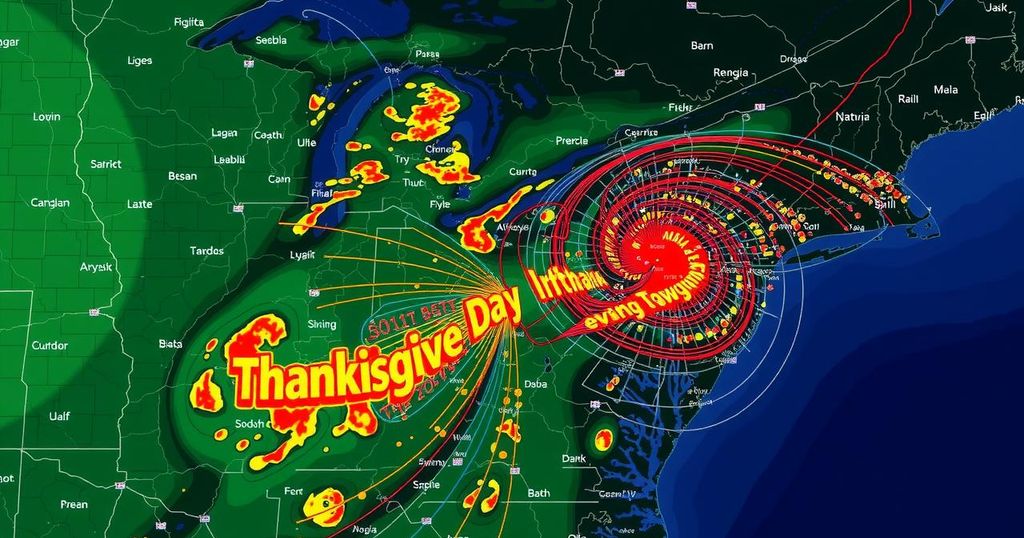Global news
AFRICA, ARKANSAS, CANTON, EARTHQUAKES, EVACUATIONS, JACKSON, LOUISA VIRGINIA, MISSISSIPPI, MISSISSIPPI RIVER, NATURAL DISASTER, NATURAL DISASTERS, NEW MADRID, NEW MADRID SEISMIC ZONE, NM, NMSZ, NORTH AMERICA, RICHMOND, RIDGELY, SHALLOW EARTHQUAKE, SOUTH AFRICA, STRAWBERRY, TENNESSEE, UNITED STATES, US WEST COAST, USGS, VIRGINIA
Fatima Khan
0 Comments
Thanksgiving Day Earthquakes Highlight Seismic Concerns in Eastern US
On Thanksgiving Day, a series of earthquakes struck the eastern United States, particularly in Virginia, Mississippi, Tennessee, and Arkansas. The strongest was a magnitude 2.5 in Mississippi, with no reported damages or injuries. These events occurred in the historically seismic New Madrid Seismic Zone, raising concerns about preparedness for future substantial earthquakes due to the area’s history of severe seismic activity.
On Thanksgiving Day, a series of earthquakes were recorded in the eastern United States, primarily affecting Virginia, Mississippi, Tennessee, and Arkansas. The most significant tremor registered a magnitude of 2.5 in Mississippi, with other events measuring between magnitudes of 1.8 and 2.1. Although some individuals felt shaking or heard a thundering noise, fortunately, no damage or injuries were reported. The seismic activity began just before midnight in Virginia, and continued into the early morning, primarily occurring in the New Madrid Seismic Zone, a region historically prone to significant quakes.
The first quake occurred near Louisa, Virginia, detected at 11:39 PM at a shallow depth of 0.3 kilometers. Following this, Mississippi experienced a magnitude 2.5 earthquake at 1:48 AM near Canton, with a depth of 5 kilometers. Western Tennessee registered a series of earthquakes shortly after, with multiple tremors felt in proximity to Ridgely, while Arkansas experienced a magnitude 2.1 quake near Strawberry. All these seismic events were relatively minor, but they did trigger discussions about preparedness for potential larger earthquakes in the region.
Significantly, the New Madrid Seismic Zone has a history of severe earthquakes, serving as a reminder of the potential for future seismic activity in the area. Notably, December 16 marks the anniversary of the first of three major earthquakes in 1811-1812, which shook the region—one registering a magnitude of 8.1. This quake was widely felt across the eastern United States, causing extensive ground movement and physical phenomena such as liquefaction, where soil and water were violently displaced. Unfortunately, precise seismic data during that period were limited, preventing a full assessment of the earthquakes’ impacts.
During the subsequent months, there were reports of over 2,000 additional earthquakes, including another two principal shocks magnitudes 7.8 and 8.8, which resulted in notable damage and loss of life. These earthquakes were accompanied by unusual phenomena, such as earthquake lights, warmer water, and a dense smoky atmosphere, raising intrigue among scientists as to the causes behind these phenomena. Despite the absence of large-scale destruction from the recent tremors, experts express concern regarding community preparedness for potentially devastating future earthquakes, emphasizing the necessity of raising public awareness.
Currently, the risk of a major earthquake occurring in the New Madrid Seismic Zone remains, with experts unable to predict with precision the timing of such an event. Given the increased population density in the region compared to the early 1800s, a significant future quake could lead to substantially greater destruction and loss of life. Therefore, it is imperative to consider preparedness and proactive measures in risk management.
The New Madrid Seismic Zone is a region in the central United States historically known for its seismic activity, particularly a series of major earthquakes in the early 1800s. The earthquakes that occurred between December 1811 and February 1812 had magnitudes as high as 8.8 and were felt across much of the eastern United States. These events serve as a cautionary tale for the potential risks associated with earthquakes in this area, particularly given the growing population. Despite the recent seismic events being low in intensity, they serve as reminders of the earthquake preparedness necessary for residents living near the New Madrid Seismic Zone. The area remains seismically active, and experts deduce that another significant earthquake is inevitable, although the timing cannot be ascertained.
In summary, Thanksgiving Day earthquakes reminded residents of the seismic activity potential in Virginia, Mississippi, Tennessee, and Arkansas, particularly within the New Madrid Seismic Zone. While the recent tremors were minor in severity and did not lead to any damages, they highlight the critical need for awareness and preparedness for larger earthquakes that may occur in the future. With historical precedents of catastrophic quakes evident in the region’s past, it is essential for communities to implement safety measures and educate the public regarding earthquake preparedness.
Original Source: weatherboy.com




Post Comment